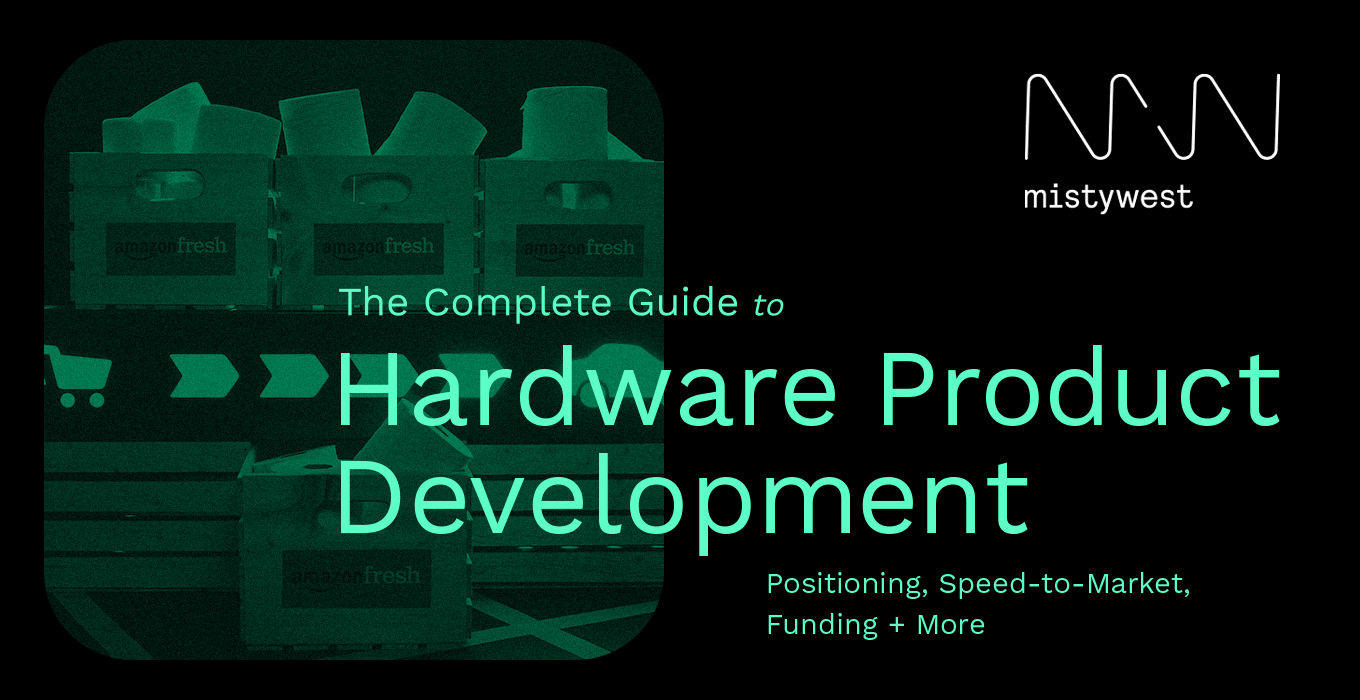
The Complete Guide to Hardware Product Development
Written by Leigh Christie, Cofounder of MistyWest, and Dan Millar, Chief Revenue Officer.
So you want to build a hardware startup?
You found a problem people care about and/or you’ve got a brilliant idea for an innovative, potentially world-changing, industry-disrupting, breakthrough technology. This idea could change the path of intelligent connected devices, edge computing and AI for future generations. It could impact the likelihood of humankind achieving the UN’s Sustainable Development Goals mission for 2030!
Now what?
MistyWest’s years of experience as an engineering consultancy in new product development have given us unique insights into building hardware startups. We’ve helped see through hundreds of projects at various stages of development – ideation to research, prototypes to Minimum Viable Products (MVPs), and mass productization and product launches.
We’ve seen products go to market, we’ve seen clients go bankrupt, and we’ve seen a lot of mistakes that could have been avoided.
Our guide is broken down into the following parts:
Part 1: Identifying Your Market Position
Part 2: Hardware Product Development Mistakes To Avoid
Part 3: Product Engineering & Prototyping
Part 4: How long does it take to launch a hardware product? (your Speed-to-Market)
Part 5: Hardware Product Fundraising
Why did we write this guide to product development?
While based in Vancouver, BC, MistyWest has worked with every type of client, from scrappy startups, to small and medium-sized enterprises (SMEs), to Fortune 500 companies. Not only have we gained knowledge through research, design and engineering, we’ve also amassed partnerships with vendors, suppliers, entrepreneurs, accelerators and VC firms, whom MistyWest works with to meet our clients’ needs.
We want to share our insights so you can bring that intelligent and connected invention from concept to consumer.
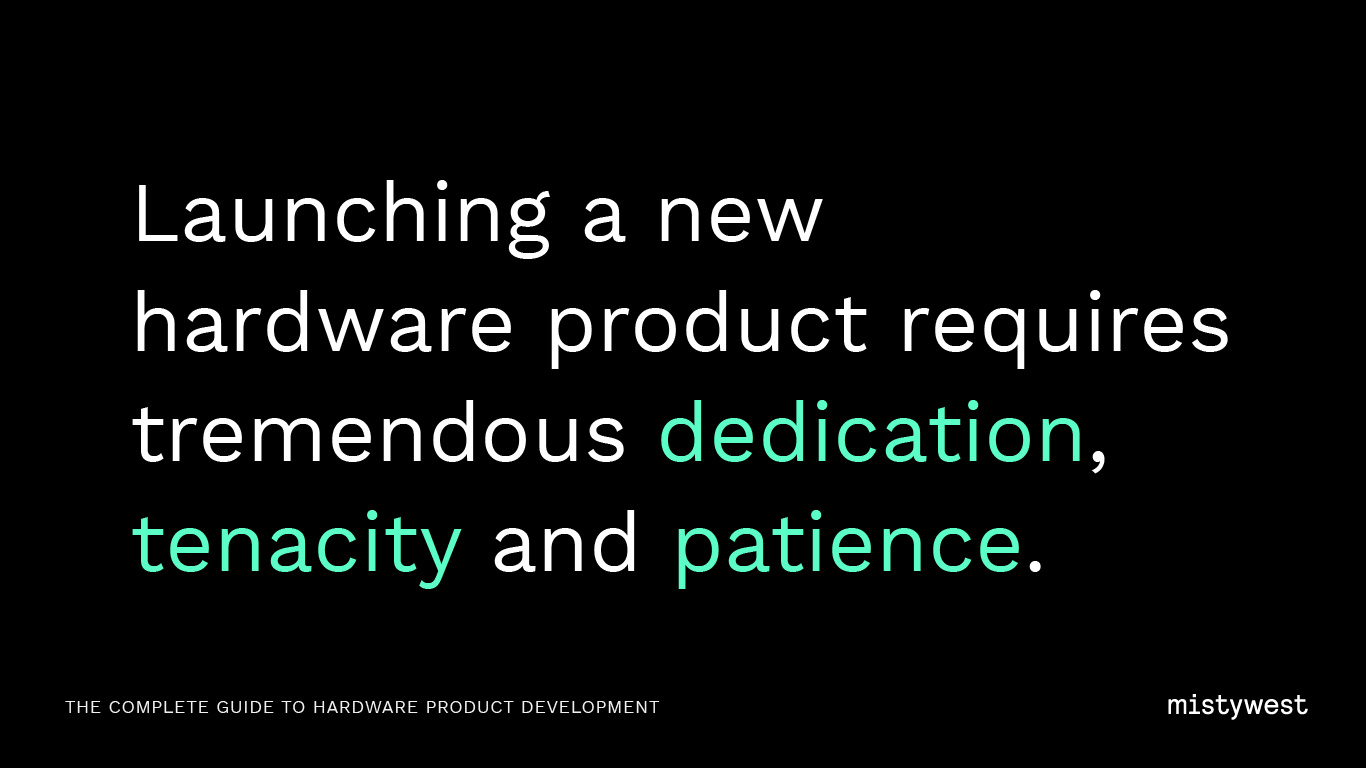
One big takeaway that MistyWest has learned from working with so many hardware startups is that launching a new hardware product requires tremendous dedication, tenacity and patience; but if you are truly passionate about solving a specific problem, it won’t matter how many setbacks (and subsequent pivots) you encounter.
Who is this guide for?
We wrote this guide to product development for:
- Entrepreneurs and intrapreneurs who are solving hard problems that require a custom hardware solution and some firmware and/or software.
- Entrepreneurs who are either raising capital or bootstrapping their hardware startup’s product development
- Intrapreneurs who are the driving force behind a new product at a medium-to-large corporation.
- Anyone that is interested in creating a hardware product where there are intelligent and connected (IoT) devices involved.
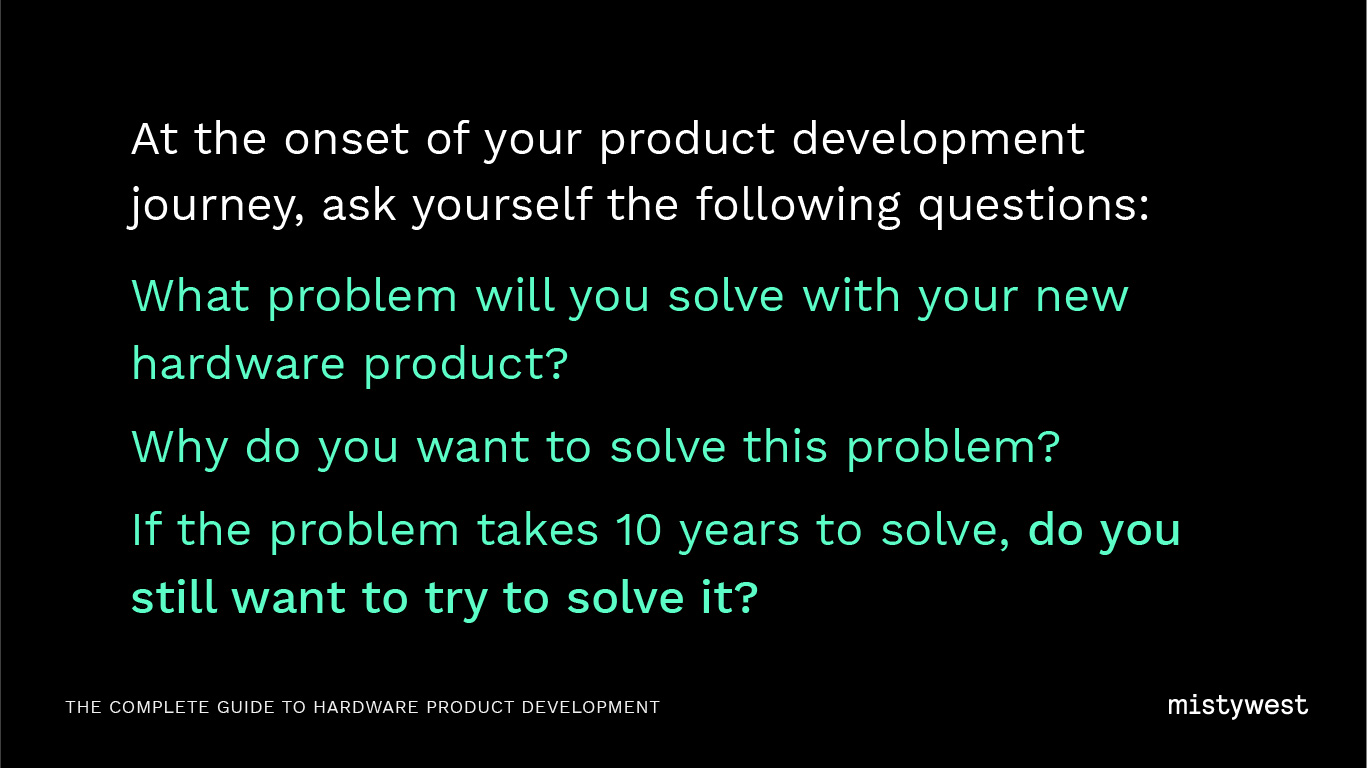
While this guide to product development is not exclusive to Canadian hardware startups, some information (such as Part 5: Hardware Product Fundraising) may be of most value to a Canadian business. That said, we encourage you to read on, regardless of your geographic location.
At the onset of your product development journey, ask yourself the following questions:
- What problem will you solve with your new hardware product?
- Why do you want to solve this problem?
- If the problem takes 10 years to solve, do you still want to try to solve it?
These questions are trying to ensure you care enough about the business you’re creating to see it through. It’s about understanding your own personal mission in life and making sure this business aligns with it. If, after answering these questions you look at your plan and can still give it an undisputed HELL YES, then we hope this series will help you make the necessary smart decisions on your journey.
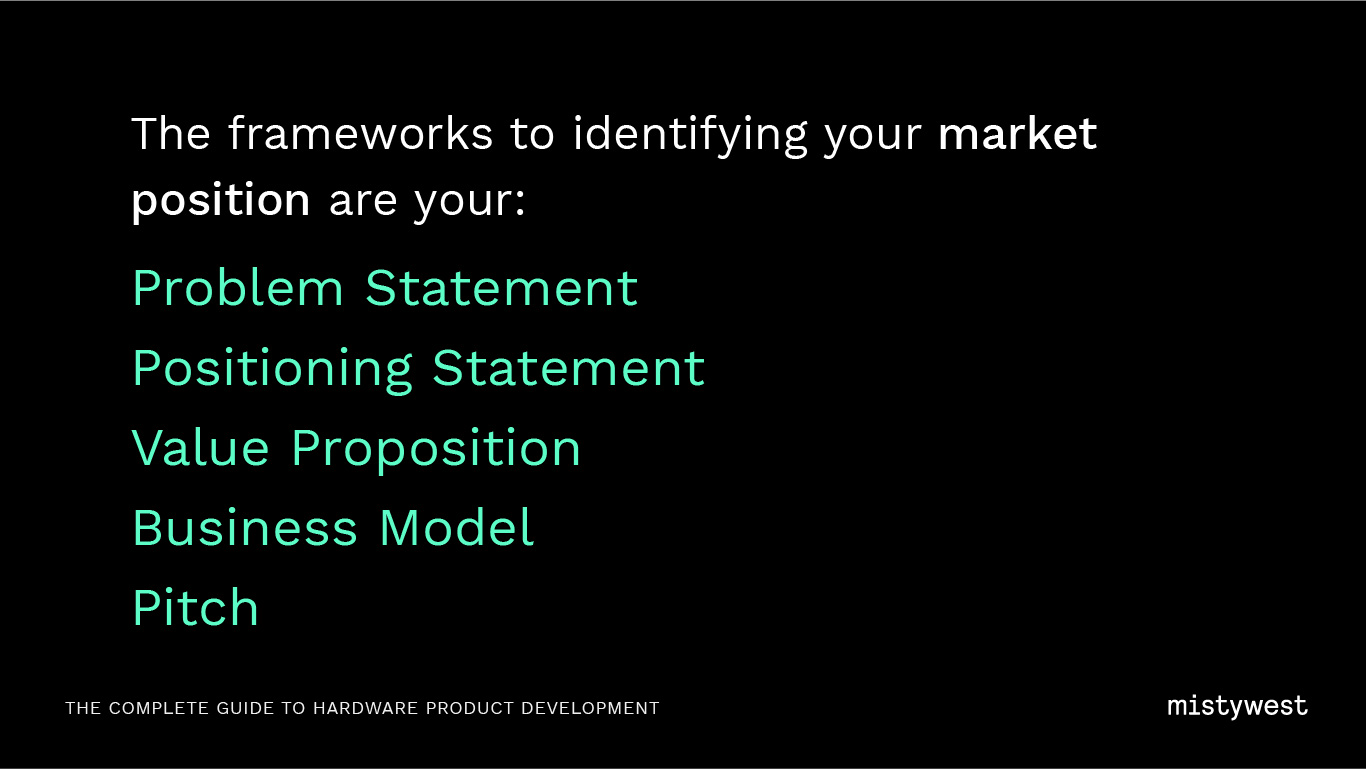
Part 1: Identifying Your Market Position
The frameworks to identifying your market position are your:
- Problem Statement
- Positioning Statement
- Value Proposition
- Business Model
- Pitch
1. Problem Statement
Sometimes you have an intelligent connected technology that can solve many problems, but you don’t know which problem to start with first. Even if you find the solution before you find the problem, it’s still crucially important that you have an intimate understanding of your customers’ needs.
Solving a clear problem will be your primary motivation for why you are developing a product. Your early customer discovery activities will help you iterate the problem statement over and over again as new information becomes available to you. You can learn more about this in Simon Sinek’s book Start with Why.
2. Positioning Statement
Now that you have your problem statement, use it to help create your positioning statement. Think of this as the basis for your 20-second elevator pitch; taking the core problem you are trying to solve and putting it into very easy to understand terms from the perspective of your customers and investors.
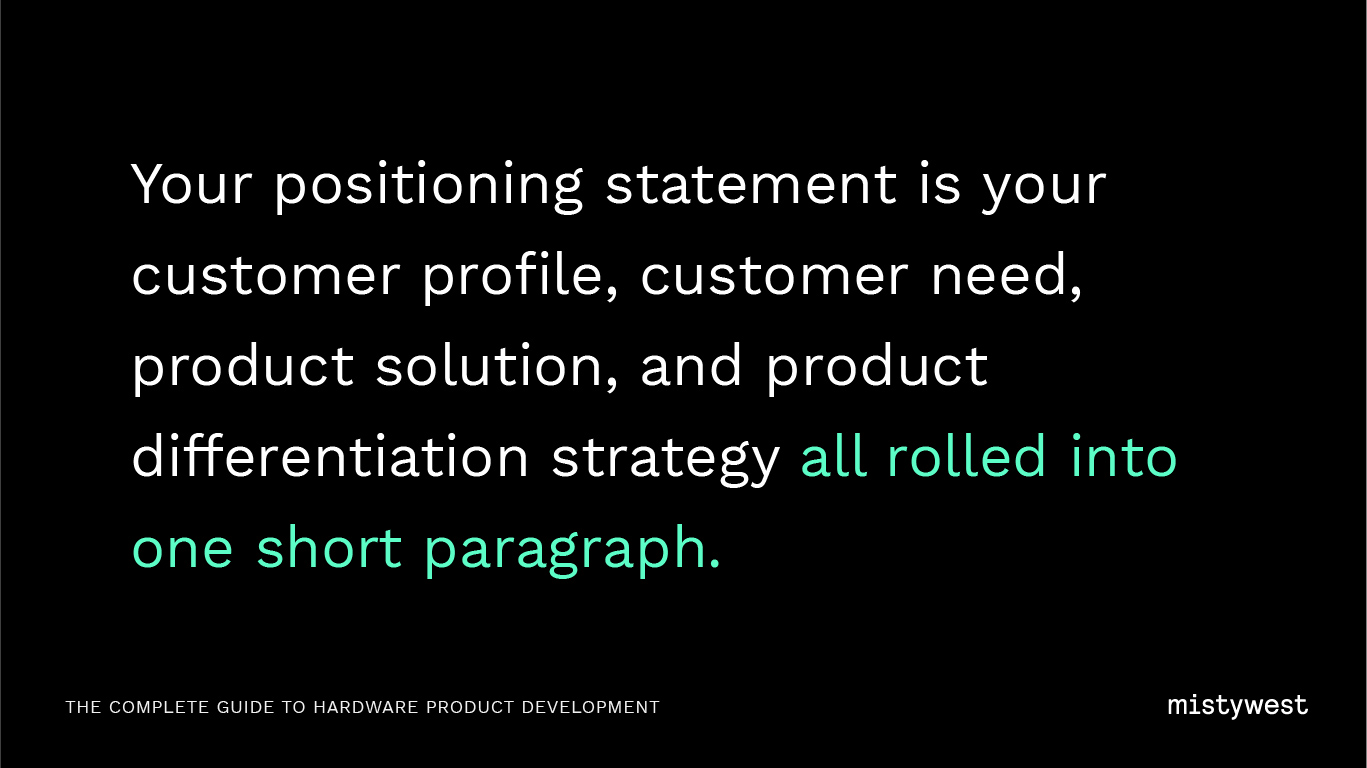
Your positioning statement is your customer profile, customer need, product solution, and product differentiation strategy all rolled into one short paragraph. All of the above may change as you gain a deeper understanding of your customers and the technologies you are developing and implementing, so iterate as needed.
Our MistyWest Positioning Statement Worksheet will help you create a clear positioning statement.
3. Value Proposition
The purpose of your value proposition is to make it obvious why a client would give you money for what you provide. This is related to your Positioning Statement but not identical, as the value proposition focuses on your product, where the positioning statement focuses on your company as a whole.
We’ve made a MistyWest Value Proposition template to help you get started.
4. Business Model Canvas
The Business Model Canvas, popularized by Steve Blank, serves as an excellent 1-page business plan. MistyWest has created a Business Model Canvas spreadsheet that also includes the problem statement, which is crucial for helping you identify your minimum viable product.
The business model canvas should be viewed as a living document with hypotheses in each section that are constantly updated, and serve as a business analysis guide on feasibility and market share.
5. The Pitch
The reason to have a good pitch is to land that next meeting – whether this is with customers, investors, or when you finally meet your significant other’s parents.
Your audience determines your pitch, and you should be ready to deliver three levels of pitches for each type of audience you expect to encounter:
- 20 second elevator pitch (your positioning statement)
- 3 minute pitch (the answer to ‘tell me more’)
- 20 minute pitch (for presenting during a 1 hour meeting, leaving plenty of time for introductions and questions)
It’s important to note that the 20 minute pitch only happens if the 20 second and the 3 minute pitches are successful. Some great resources for structuring pitches include Simon Sinek’s now famous TED talk, and examples from VC-funded companies, Launch Academy, and Innovate Calgary.
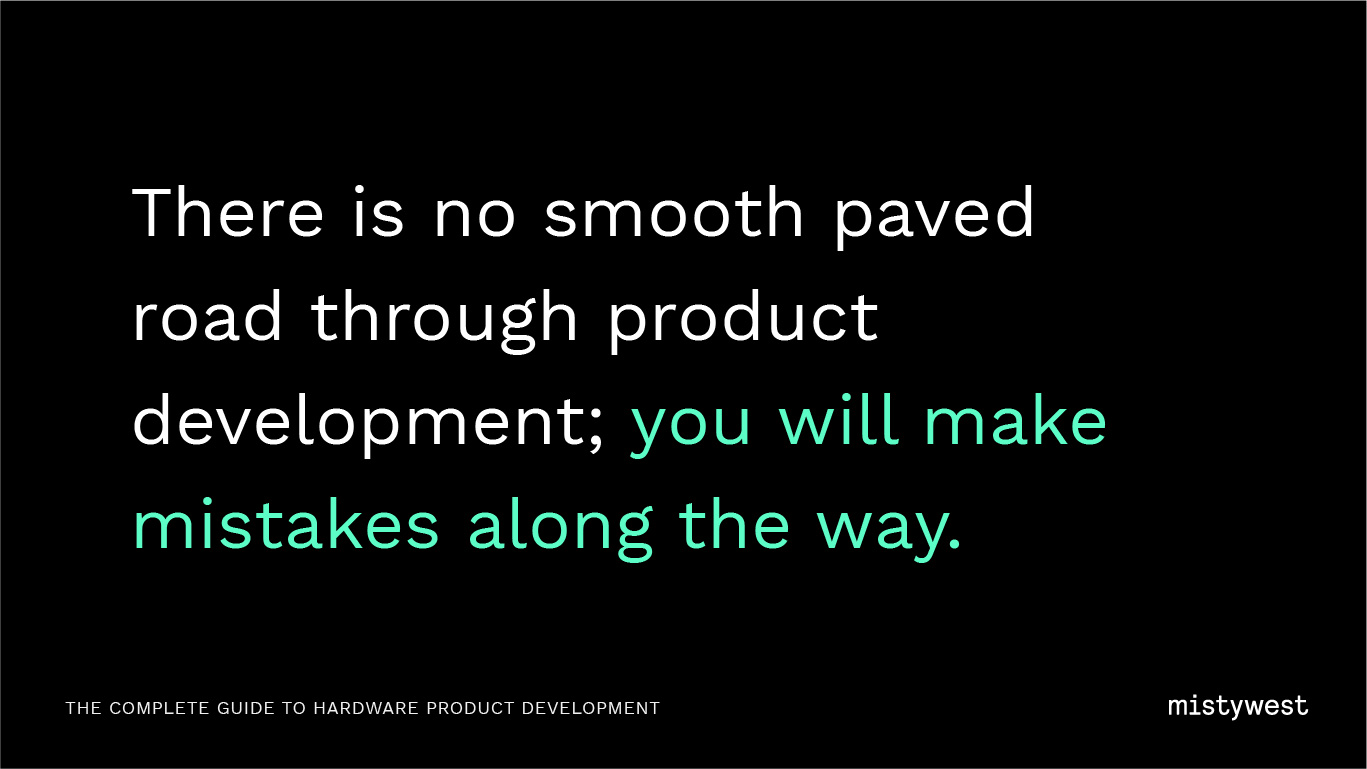
Part 2: Common Hardware Product Development Mistakes To Avoid
There is no smooth paved road through product development; you will make mistakes along the way. Each hardware journey is unique, and you will inevitably run into roadblocks, technological headwinds, or pandemics that your previous experience could not have prepared you for.
MistyWest’s engineers and business developers have diligently tracked common product development mistakes that could have been avoided, and broken it down to the following 5 most frequently occurring.
Mistake To Avoid #1: Not prioritizing product-market fit
No matter how much you love your intelligent connected hardware product, it doesn’t mean you’ll be able to find customers. If you fail to conduct sufficient user testing, or fail to demonstrate the product to the ideal customer early enough in the design process, you’ll be making crucial product decisions with insufficient product and market research, leading to an MVP that does not align with your value proposition.
Hardware prototyping enables you to get feedback from your customers long before they are able to buy the product so you can make better decisions on what the minimum feature set should be for your MVP (see Part 3: Product Engineering & Prototyping). If your prototype doesn’t meet your target customer’s expectations, you either need to keep testing and re-engineer your product, or change your value proposition and target customer to match your product. Otherwise, you’re going to be left with a lot of boxes of unsold MVPs.
Eric Reis said it best in his book The Lean Startup:
“If you are building the wrong thing, optimizing the product or its marketing will not yield significant results.”
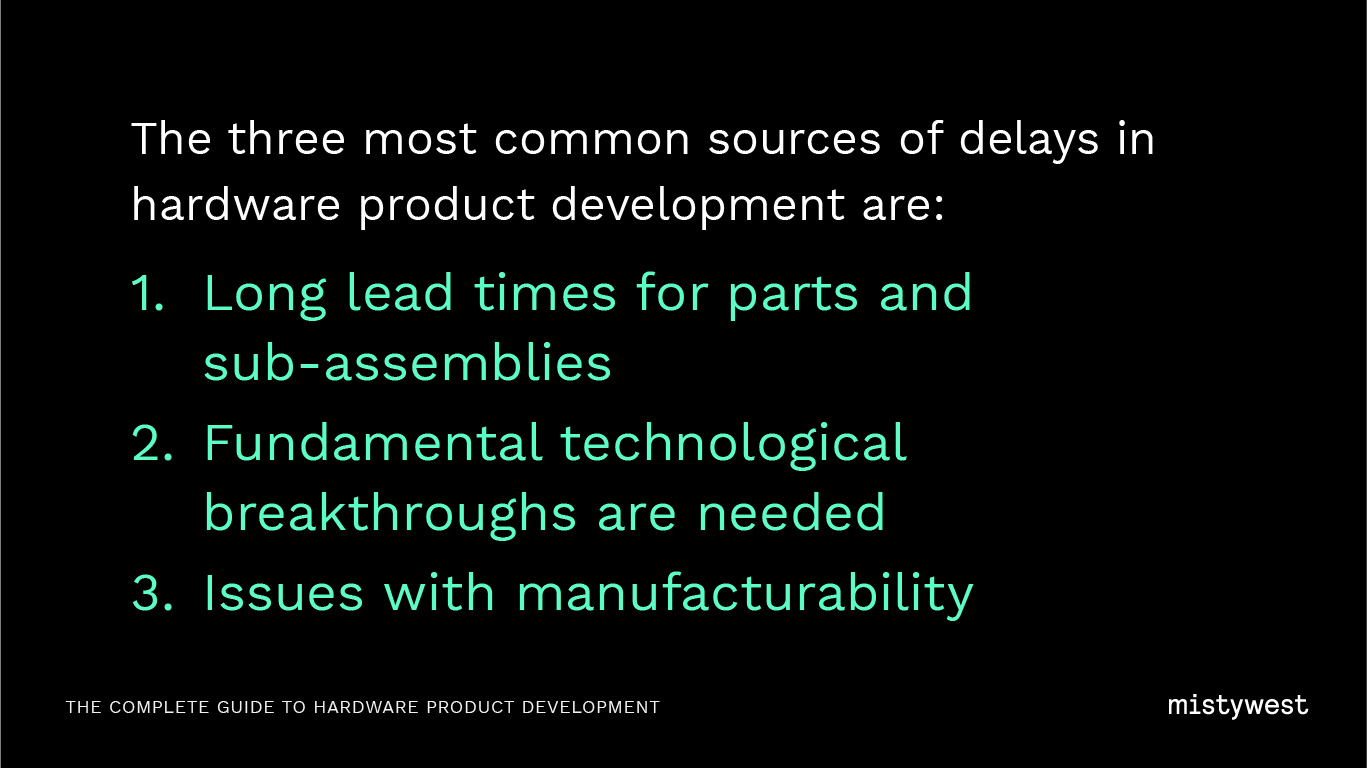
Mistake To Avoid #2: Underestimating the product development timeline
The three most common sources of delays in intelligent connected hardware product development are:
- Long lead times for parts and sub-assemblies
- Fundamental technological breakthroughs needed
- Issues with manufacturability
The hard truth is that building a functional prototype takes about ten to a hundred times as much engineering time and resources as it takes to get through the early product development stages. If your hardware product is complex and requires certifications and validation testing (such as medical devices), that can double (or triple) your timelines to get to a production prototype. And it can take the same amount of time again to work out all the bugs during manufacturing.
The time it will take to go from concept to pilot production is extremely variable – it can be anywhere from 6 months to 2 years for “low certification” products, and 2 to 5 years for hardware products that require extensive certifications. For products that require technology breakthroughs–such as fuel cells–it can take 30 years or longer!
Mistake To Avoid #3: Not asking for engineering consulting help early enough
Your non-recurring engineering (NRE) cost is the one-time cost to research, design, develop and test a new product or product enhancement. NRE includes all phases from concept/ideation until the start of commercial production, and continues to include the costs of fixing bugs and Engineering Change Orders (ECOs) after production has already started. NRE does not, however, include the cost of manufacturing, marketing or sales.
Some examples of NRE include:
- R&D for very immature technologies
- Industrial Design
- User Experience (UX) Design
- Mechanical Engineering
- Electrical Engineering
- Embedded Firmware Development
- Software Development
- Design for Manufacturing (DFM)
MistyWest has heard many of the same stories from our clients: they hired a collection of freelance or inexperienced engineers and designers in an attempt to save money, but it ultimately led to poor quality assurance, a lack of accountability when things went haywire, leaking of information to competitors, or intellectual property (IP) theft.
Many clients also come to us after having worked with Original Design Manufacturers (ODMs) for their engineering assistance, who offer affordable services but may also lead to a loss of control over your IP, your bill-of-materials (BOM), your supply chain, your design files, your tooling, and your negotiating power.
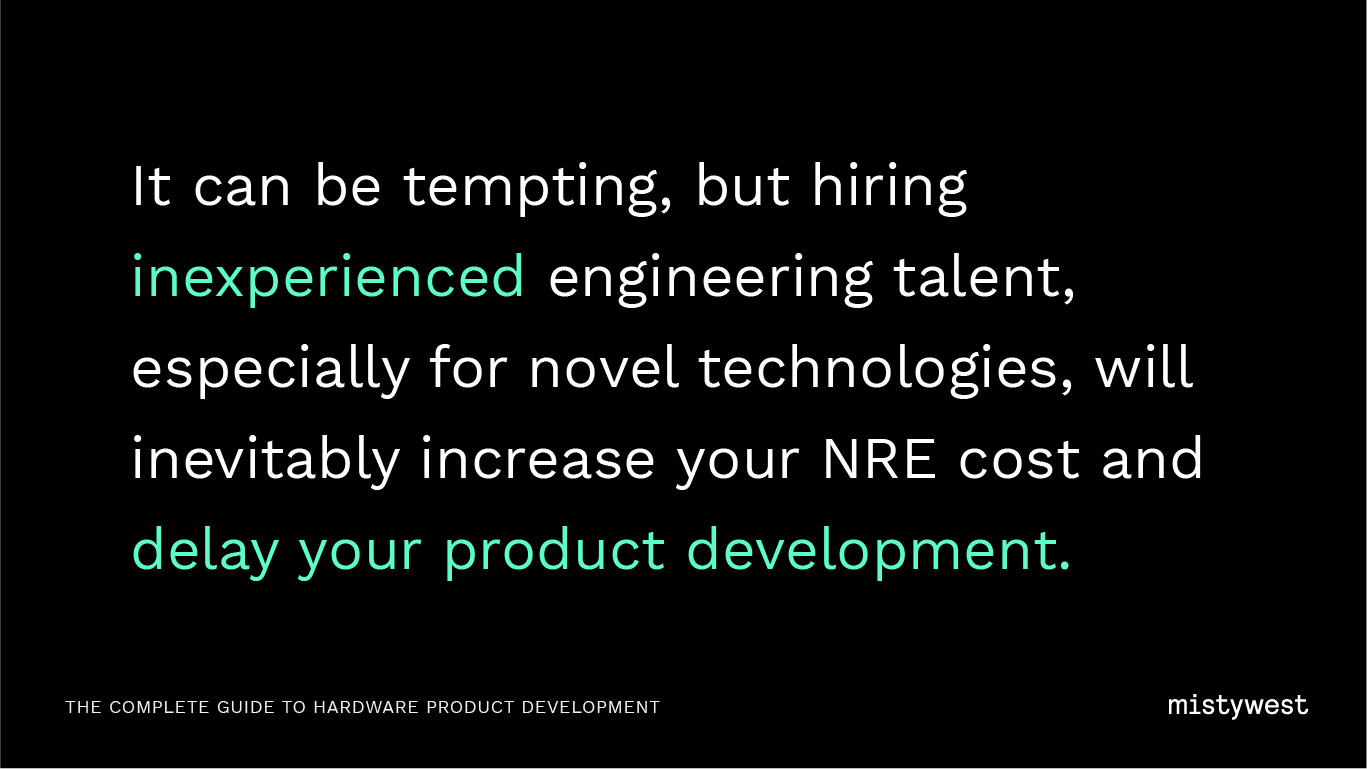
It can be tempting, but hiring inexperienced engineering talent, especially for novel technologies, will inevitably increase your NRE cost and delay your product development. Hiring an engineering consultancy enables founders to set their own terms for budget, quality and timeline. Believe us; MistyWest has been called in to rescue many projects where the client could have saved a fortune if they had involved us much sooner.
Mistake To Avoid #4: Not being focused enough
You’re a brilliant entrepreneur who has a great idea – and way too many other ideas.
Once you’ve made sure you’re building the right thing (see Mistake 1), ignore your other product ideas, no matter how great, and focus on your MVP feature set.
Focusing on too many intelligent connected features or products can eat up your resources, such as funding and engineering talent, and lead to wasted efforts.
This same advice goes for entrepreneurs who have two or more businesses on the go at the same time: cut these other side projects out of your life and focus on a single product. Focusing your hardware product development efforts will dramatically increase your chances of success.
Mistake To Avoid #5: Not raising enough funds
You may want to spend the bulk of your time on strategy, recruiting, designing and selling. In comparison, fundraising can feel like an unwanted chore. However, a lack of monetary investment will lead to a slower speed-to-market and can cause the loss of your First Mover Advantage, leaving a competitor to reap the rewards of your new technology.
In the early days of your hardware startup, you may end up spending more time raising money for your product development than on any other activity. If you hate fundraising, consider finding a partner who can work with you to help you raise the capital you need to execute (see Part 5: Hardware Product Fundraising).
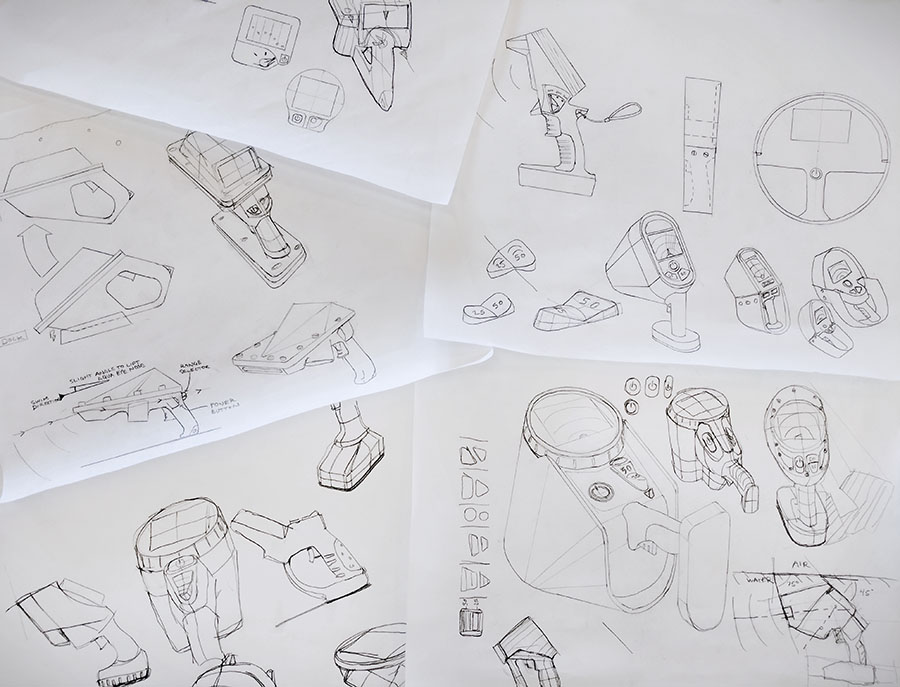
Part 3: Product Engineering & Prototyping
The MistyWest Product Development Process is broken down into 3 Stages: Ideation, Prototyping and Productization, where we make use of an agile product development approach.
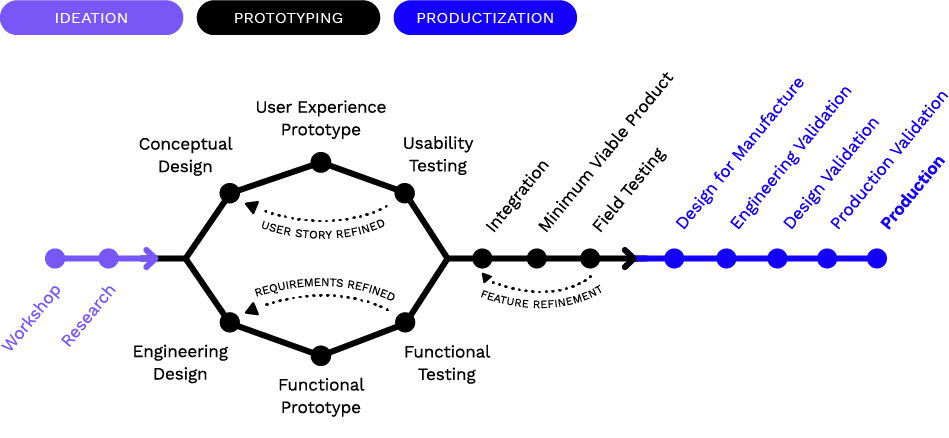
Our Ideation stage yields a Proof-of-Concept (PoC) to determine that our client’s goal is technically feasible. The Prototyping stage determines how the device will work, and relies on many iterations, including user experience (looks-like) prototypes, functional (works-like) prototypes, and eventually the MVP. MVPs are subjected to beta (field) testing for feedback, and the core features of the prototype are implemented. The Productization stage takes the MVP and determines what fun (and perhaps superfluous) features are of interest to the test audience, and finally, on to mass production.
Why Hardware Prototype?
The purpose of hardware prototyping during product engineering is to answer those hard questions, ranging from technical unknowns to getting a better understanding of your end-users and/or market. This enables our engineers to learn about technical challenges while our clients learn more about their users.
A compelling intelligent connected physical prototype can make or break a new hardware product initiative by giving you credibility when you start advertising–especially for novel products that have never existed before–and can answer questions around consumer demand.
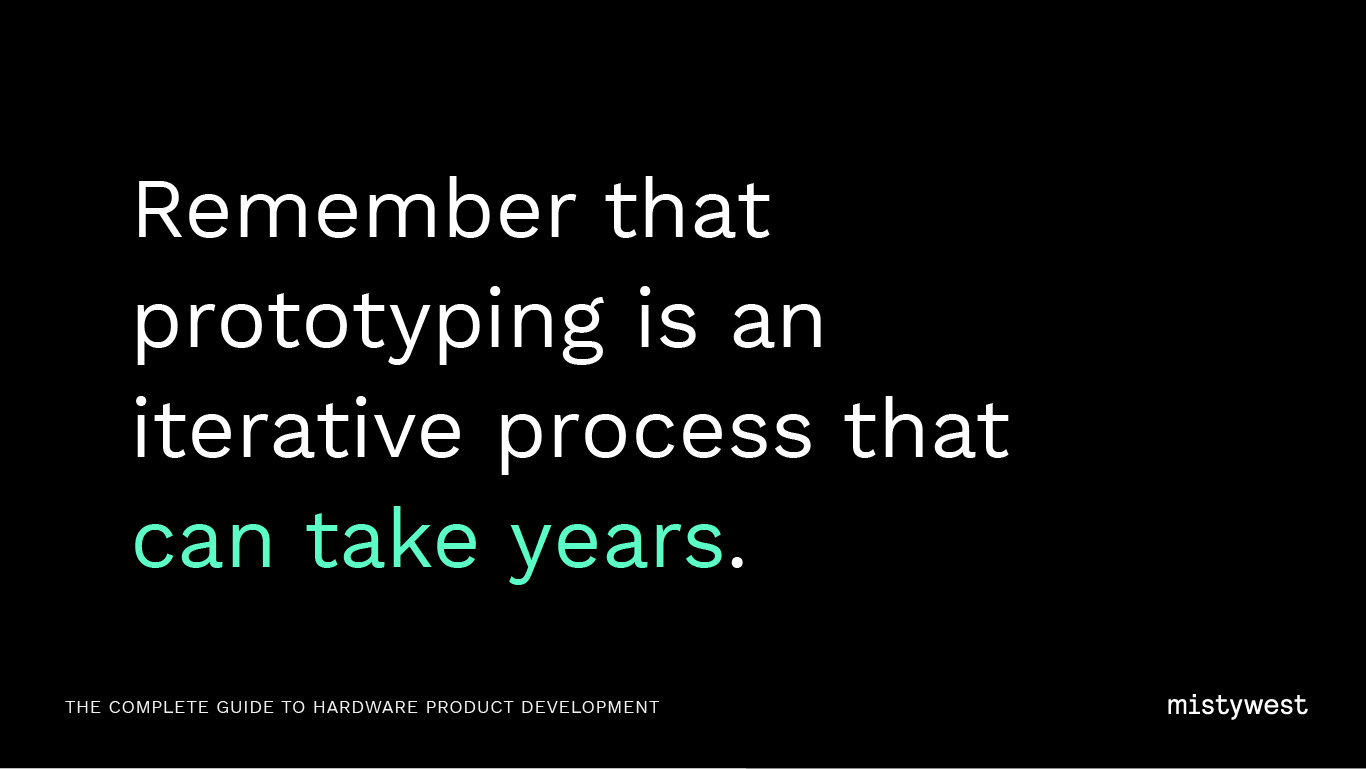
Remember that prototyping is an iterative process that can take years; you will need to create many prototypes and test often to learn as much as possible before you lock down the feature set for your MVP.
The following are useful questions you should ask yourself during the prototyping process:
Consumer or User Demand
- What are the minimum set of features for our MVP that solves the problem and meets the users needs.
- How high will consumer demand be for this MVP?
- What does our speed-to-market need to be?
Strategy and Investment
- What aspects of our designs are novel and can be patented?
- How can we gain a long term sustainable competitive advantage?
- How large is the Total Addressable Market for our business plan?
- How much money do we need to raise, and what should we be spending our product development money on?
Performance and Cost
- What materials should be used?
- If needed, will the product pass certification?
- What is the trajectory of progress for product development, performance and cost? Or how much better can future prototypes be?
- How well does the prototype function relative to consumer expectations?
- What is the BOM cost for the prototype (assuming production ready materials, components, and manufacturing methods are used)?
- Can a BOM cost-down be done?
- Does the alpha prototype meet the specification during alpha testing?
- How will the product be serviced and maintained? (design for serviceability)
- If needed, how will the firmware and software be updated?
- How will the product be assembled (design for assembly)
- How will the product be manufactured (design for manufacturing)
Part 4: How long does it take to launch a hardware product? (your Speed-to-Market)
What is Speed-to-market?
Speed-to-market is the amount of time it takes to get from concept to delivery of the first revenue generating units delivered for a given product. Whether it’s B2B or B2C or B2B2C, when we’re talking about speed-to-market, there is always a trade-off between cost, performance and speed.

If your product requires novel technologies but you have inexperienced engineers and a modest budget, your speed-to-market will be very slow. If you reduce features and performance targets, or cut corners on engineering and your NRE, your product’s quality will suffer or will be vulnerable to competition.
Why does speed-to-market matter?
To understand why speed-to-market is important, you need to understand the concept of First Mover Advantage, which is the benefits accrued to the company who develops and commercially launches a new product before their competitors are able to do so.
With the First Mover Advantage you get all the benefits that come with being the market leader, which can include:
- Capturing the majority of the Press/PR
- Capturing the public’s imagination
- Developing a strong brand loyalty
- Being considered as the “original” or “most innovative”
- Being first to patent, and learning what IP is/is not important
- Exclusive deals with vendors/partners/IP-licenses to prevent fast followers from catching up
What are the downsides to being first to market?
A downside to being first to market is that if your product is easy to copy, you have now shown your competitors which way to go if they reverse engineer your product. You’ve spent a lot of money on NRE costs that competitors might not have to spend if they can avoid it, and if your novel product proves there is a market, then your competitors no longer need to weigh that risk or do that research.

What determines speed-to-market?
Speed-to-market is determined by many factors, and the time it will take to go from concept to pilot production is extremely variable. You will need to consider:
- The problem trying to solve (your value proposition)
- The complexity of your product’s hardware, firmware and software features
- The amount of NRE required, and the level of engineering expertise and experience on your team
- Your budget and required funding
- Product safety and required certifications
- Product manufacturing complexity (number of parts, size, number of interacting subsystems, and ease of assembly)
- Off-the-shelf technology and supply chain readiness
Part 5: Hardware Product Fundraising
“Some people got to have it, Some people really need it” – The O’Jays
Hardware technologies and physical devices have the ability to capture the imagination of future generations like nothing else – just look at the first iPhone. There is something about “tangible” technologies that we can interact with that help inspire great change in the world.
That said, it’s very hard to raise capital for hardware startups (the old cliche “hardware is hard” rings true) and it can be the single hardest part for entrepreneurs to grapple with – but the value of these types of startups to the regional economies who support them are enormous.

Funding can generally be broken into two types: Dilutive and Non-dilutive. Dilutive funding is what you see on Shark Tank or Dragon’s Den, where a company gives up a portion of ownership for some level of investment. Non-dilutive funding doesn’t have slick TV shows about it, but it’s typically much nicer than dealing with Kevin O’leary.
Dilutive Funding
Unless you’re independently wealthy, it’s likely you will want outside money to accelerate product development and sales growth, and depending on your business and your current financial situation, how and when you raise dilutive funding will vary greatly. Below are things to consider when seeking outside funding in your startup.
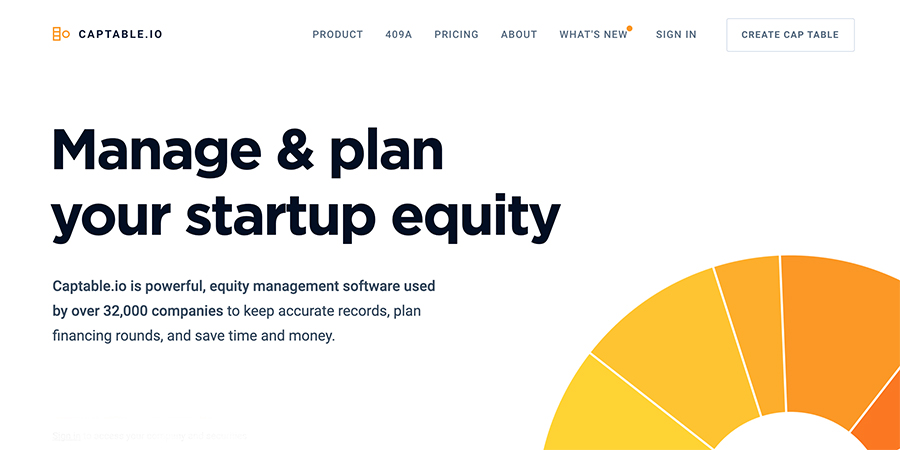
Captable.io is an option for managing your investors
Capitalization Table 101
At the highest level, a capitalization table is a list of your company’s securities, such as A Shares, B Shares, Options, and Warrants. Use a spreadsheet that tracks who your shareholders are, how many of each class of shares they have, what they paid and what percentage of the company they own. You can even try online platforms like captable.io for managing your startup equity.
Friends and Family
I hope you were always polite when passing the gravy to Aunt Mildred at Thanksgiving, because now’s the time to give her a call and see if she’s willing to take a bet on you.
This round of funding is exactly what it sounds like: you go out and ask your friends and family with disposable income if they’d like to invest. If your idea is not yet ready for angel investors (as is most often the case), it’s crucial to find early supporters for getting your idea off the ground and moving towards a refined prototype, so you can demonstrate real value to angel or venture capital investors. A typical ‘Friends and Family’ round of fundraising is $20K to $500K in size.
Angels
Angel investors are likely much more sophisticated investors than the ones you were dealing with in the friends and family round. At this stage, you will be looking to raise between $100K and $2M.
Globally, there are many Angel networks, and some networks in British Columbia include:
- National Angel Capital Organization
- VANTEC Angel Network
- Angel Forum – Vancouver
- Vancouver Entrepreneurs Forum (VEF) (though not technically an angel network, it largely operates as one)
- WUTIF Capital
- National Angel Capital Organization
- Angel List for Vancouver
- E-Fund
- Valhalla Angels
Venture Capitalists
Venture Capitalist (VC) firms are a huge part of what made the Bay Area boom, and can be critical for making the leap to commercialization or development of products with high technical risk. If you want to pitch a VC, you’ll need to polish your value proposition, have a large total addressable market, and project extreme growth in order to get a meeting with one.
Some British Columbia based VC firms are:
- Conconi Growth Partners
- Vanedge Capital
- Bullrun Capital
- Renewal Funds (Environmental)
- Nimbus Synergies (Medical)
- Amplitude Ventures (Medical)
- Novature Ventures (Medical)
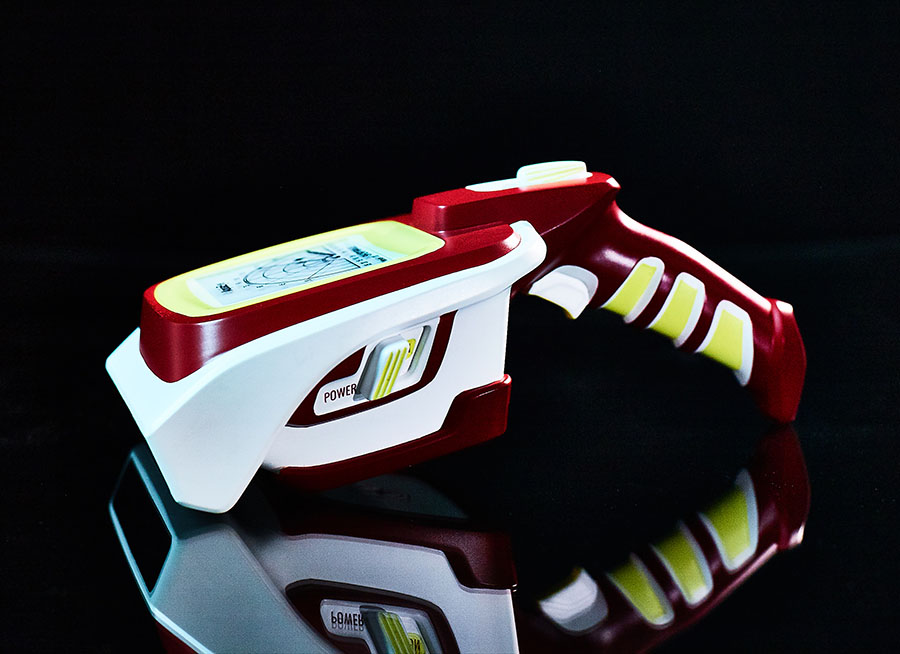
MistyWest’s prototype of the AquaEye for the startup VodaSafe
VC fundraising rounds are classified by letter, as Series A, B, etc. and typically start between $1M and $5M for a Series A and go up 2 to 10 times per round. A funding success story includes our client VodaSafe securing Series A financing with VanEdge Capital for their life-saving underwater scanning device the AquaEye in 2020.
Non-Dilutive Funding
The money’s just as useful as dilutive sources, but your cap table stays empty. Hurray!
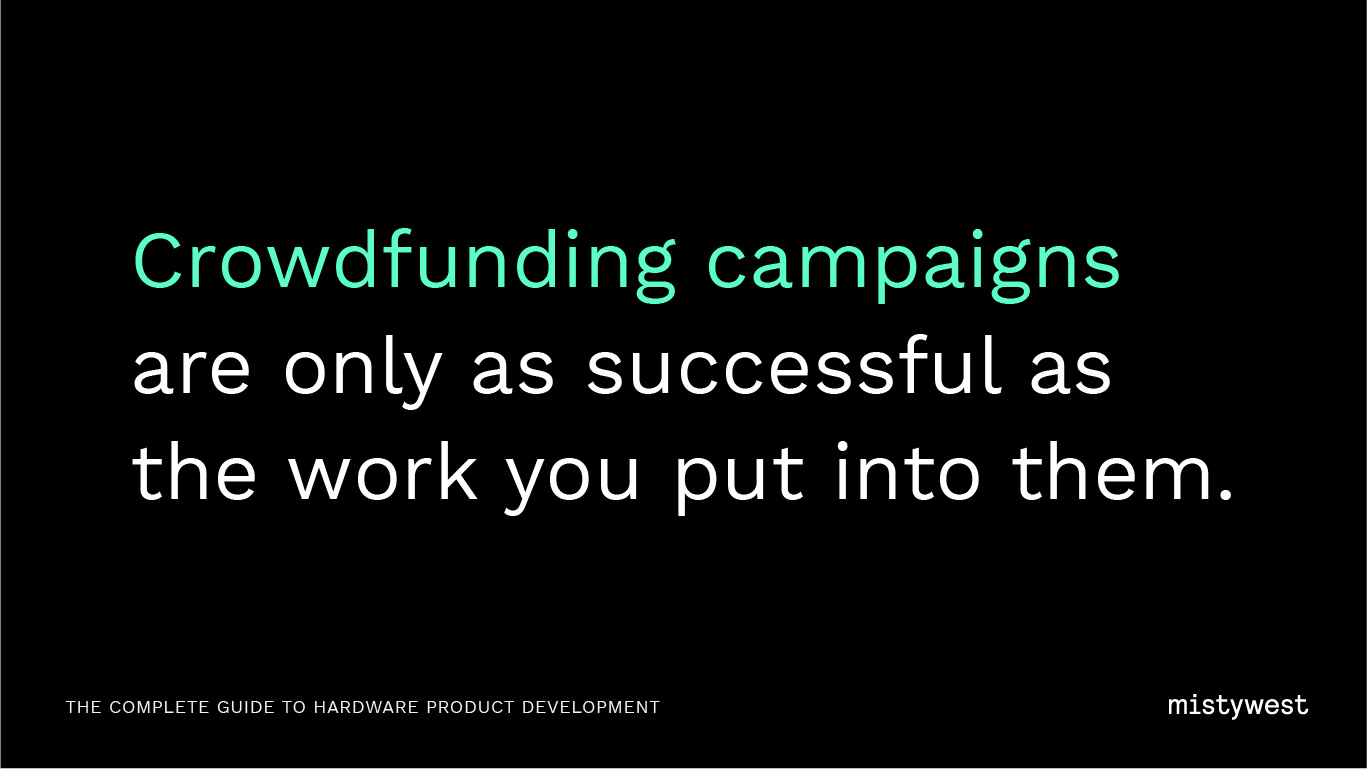
Crowdfunding
If you’re fundraising for a consumer product that a backer can personally own or benefit from, Kickstarter or IndieGoGo are a reasonable option. While it’s unlikely that you’ll be financing your entire business via crowdfunding, it can provide valuable working capital and, even more critically, market validation to raise additional capital against.
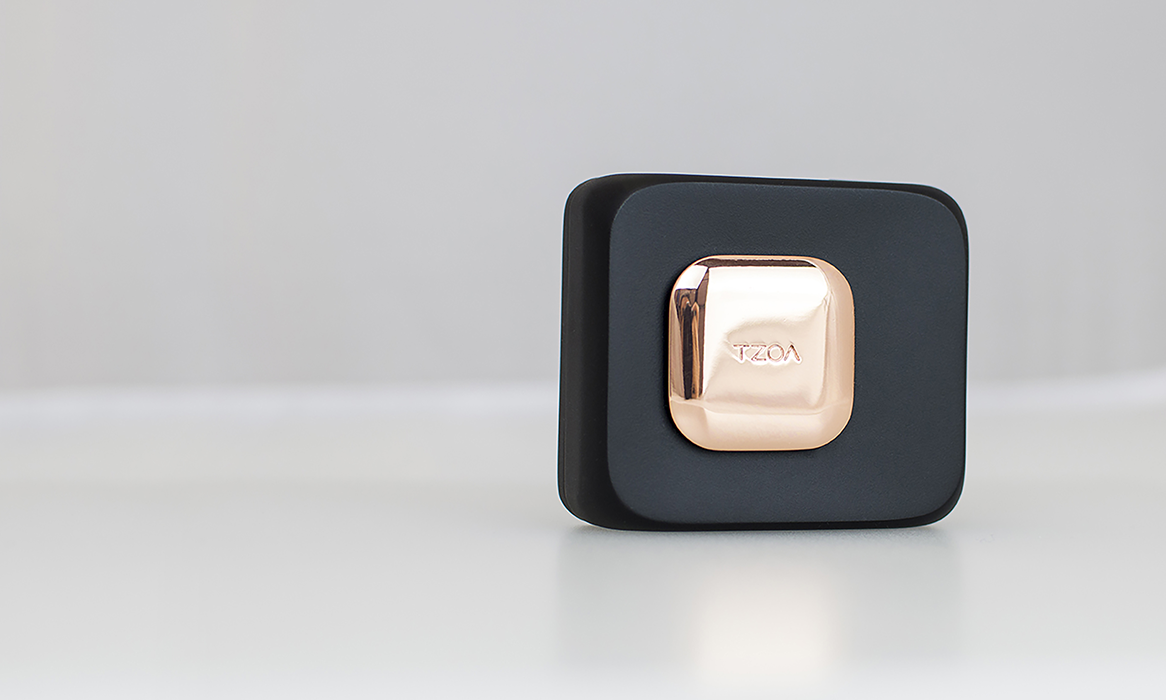
Crowdfunding campaigns are only as successful as the work you put into them, so if this is your first time, consider bringing on a professional to help and do your research ahead of time. After more than a year of dedication to their product’s development, MistyWest’s client TZOA successfully ran an IndieGoGo crowdfunding campaign in 2015 for their first wearable indoor air quality monitor.
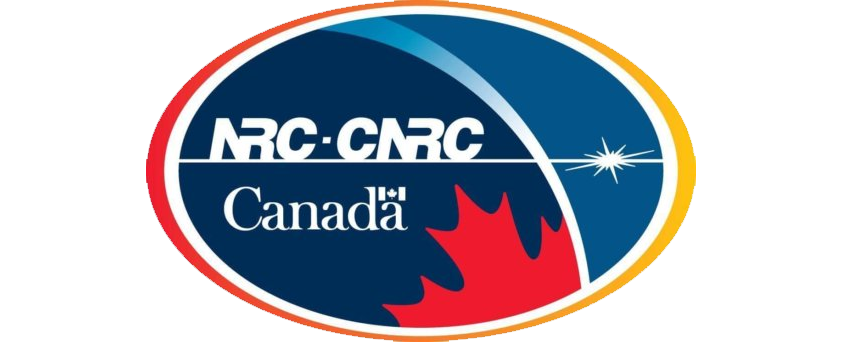
Industrial Research Assistance Program
Canada’s National Research Council Industrial Research Assistance Program (IRAP) is an excellent option for non-dilutive grant funding for research and development projects. While it requires you to find additional funding sources that IRAP will match, it can offer your early investors confidence that their money will be well leveraged. IRAP also offers the YEP program for hiring recent graduates.
SR&ED
Similar to IRAP, SR&ED (Scientific Research & Experimental Development) offers support for technically risky research projects through a retroactive tax credit. Up to 62% of salaries, 42% of materials and 32% of sub-contractor expenditures can be recovered through SR&ED. It’s recommended to work with a local company that specializes in SR&ED claims.
To be eligible for SR&ED, your project must involve:
- Technological advancement (what you are building must not be readily available in standard practice)
- Technological uncertainty (there is some risk of failure and the outcome can not be perfectly predicted)
- Technical content (work was performed systematically and included documentation)
Other Government Funding
There are new programs all the time to help spark innovation in Canada and BC. The government of Canada has created a concierge program to help navigate this.
Debt Financing
First thing’s first: we don’t recommend maxing out your personal credit cards to fund your hardware startup.
There are a number of options for debt financing (i.e. taking out a loan), and as your hardware startup increases its assets and revenue, additional options from traditional lending institutions will become available. Several funds and venture capitalist firms specialize in debt financing, including Espresso Capital and Vistara Capital.
Options for debt financing in Canada include:
- Futurpreneur and BDC: A collateral-free loan–up to $15,000 from Futurpreneur and $30,000 from BDC–with preferred rates and mentoring for people ages 18 to 39.
- Genome BC: A $1 million loan with a 4 year grace period for the principle, and repayment of interest based on royalties. This loan is available for reasonably well established startups in healthcare or industrial applications of genomics or proteomics. Their due diligence is very thorough.
- BDC business loans: Likely the most common way that Canadian companies get loans greater than $50K. BDC has several funding options that range from general debt financing, to financing specific, to capital purchases or working capital.
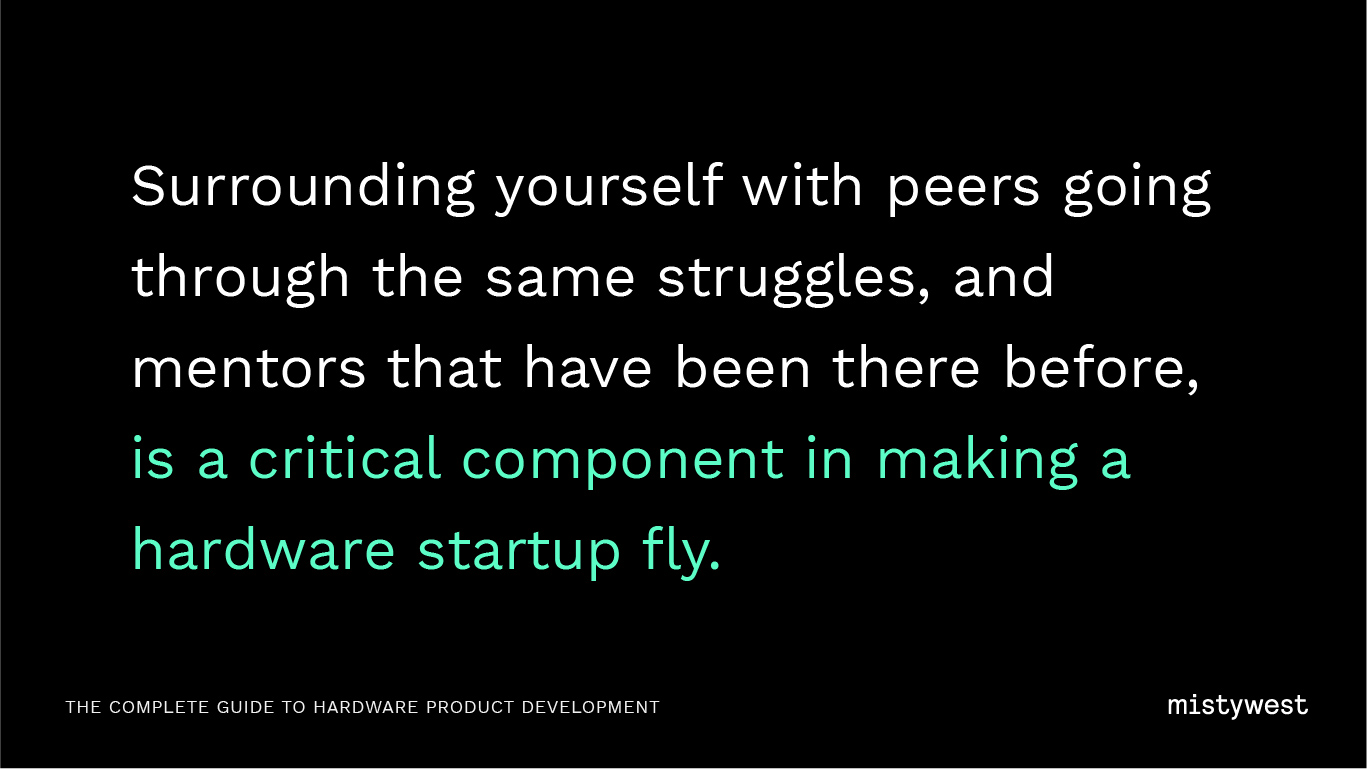
Accelerators and Incubators
Surrounding yourself with peers going through the same struggles, and mentors that have been there before, is a critical component in making a hardware startup fly.
The major incubators, accelerators, and similar programs to investigate in the lower mainland include:
- e@UBC (must have a UBC affiliation of some kind)
- Lean LaunchPad (very early stage)
- Hatch (more mature)
- CDL-West (more mature than Hatch)
- SFU Ventures Lab
- Radius SFU
- Spring
- Zen Launch Pad
- Launch Academy
- Rocket Academy
- Highline Beta
- Foresight Clean Accelerator
- New Ventures BC
Conclusion to our guide
We hope this Complete Guide to Product Development has gotten the wheels turning and empowered you to do some research and start putting your plan into action. If you’re worried about making some mistakes along the way, don’t worry – that’s part of the journey, and MistyWest is here to help you through it.
MistyWest has supported hardware startup clients by making introductions and offering them exceptional engineering to build better products. We have dozens of product development case studies and have achieved extraordinary customer experiences that win awards.
If you’re looking for more guidance on your hardware startup’s journey, reach out to a MistyWest business developer at [email protected] and share the problem you’re solving.
You can also download a MistyWest capabilities statement to learn more about our expertise in idea generation, product design and productization.